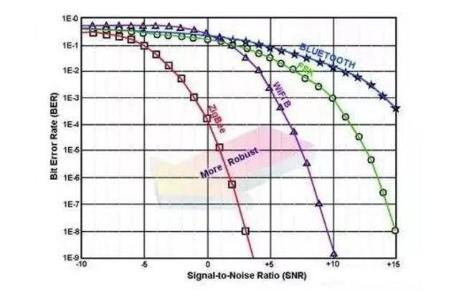Zigbee is a wireless technology similar to Wi-Fi and Bluetooth, based on the 802.12 standard of the Institute of Electrical and Electronics Engineers (IEEE) standards association. Wi-Fi can transmit a lot of data at high speeds, while Zigbee mainly transmits smaller amounts of data, such as instructions on how to operate, between devices such as switches and sensors.
The anti-interference feature of ZigBee is mainly anti-co-channel interference, that is, interference from other technologies that share the same frequency band. The main features are as follows:
1. Clear Channel Assessment (CCA):
Determine whether the channel is idle. The IEEE802.15.4 physical layer provides the capability of CCA in the collision avoidance mechanism, that is, if the channel is occupied by other devices, the transmission is allowed to exit without considering the communication protocol of the channel.

There are currently three free channel evaluation modes:
(1) Determine the signal energy of the channel. If the signal energy is lower than a certain threshold, the channel is considered idle;
(2) Determine the characteristics of the wireless channel, which mainly include two aspects, namely spread spectrum signal and carrier frequency;
(3) Summarize the first two forms, detect signal strength and signal characteristics together, and give channel idleness judgment.
2. Dynamic channel selection
The coordinator (the central node of the network, responsible for the deployment and maintenance of the network) in the ZigBee Personal Area Network (PAN). First scan all channels, and then identify and add a suitable PAN (no need to create a new PAN) to reduce the number of PANs in the same frequency band and reduce potential interference. If an interference source appears on an overlapping channel, the software on top of the harmonizer uses a channel algorithm to select a new channel.
3. Channel algorithm
When the network is initialized or the response is interrupted, the ZigBee device will first scan a series of channels that are included in the channel table parameters for dynamic channel selection, and set the channel table parameters according to the above-mentioned idle channels to enhance the coexistence function of the network.
During severe interference, ZigBee does not change the channel, but relies on its low duty cycle, collision-free algorithm (each device listens to the channel before sending data) to reduce data loss caused by transmission collisions.
4. Direct sequence spread spectrum technology (DSSS) and fast frequency change FA
Direct sequence spread spectrum technology has a certain anti-interference effect, and the transmission distance is larger than frequency hopping technology under other conditions being the same. The so-called rapid frequency change is to change the frequency to avoid the influence of a known interference source or signal source.
5. Cope with retransmissions and frame buffering
The MAC layer and application layer (APS part) of ZigBee have automatic request retransmission ARQ and frame buffering functions. When transmitting a data frame to a device, if the receiving device is busy or sleeping and cannot receive the frame, the main coordination device of the network temporarily buffers the frame until the receiving end receives the frame.Keywords: 16-channel IO control